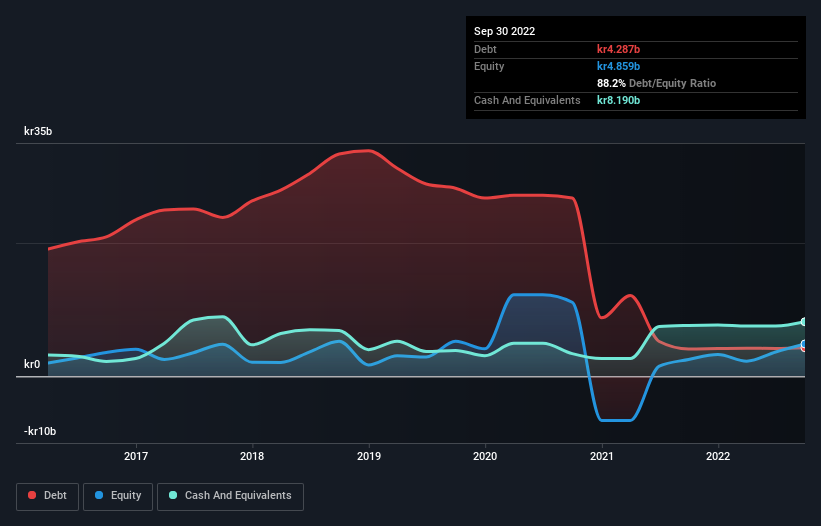
Some say volatility, rather than debt, is the best way to think about risk as an investor, but Warren Buffett famously said that 'Volatility is far from synonymous with risk.' When we think about how risky a company is, we always like to look at its use of debt, since debt overload can lead to ruin. As with many other companies Norwegian Air Shuttle ASA (OB:NAS) makes use of debt. But should shareholders be worried about its use of debt?
When Is Debt A Problem?
Debt is a tool to help businesses grow, but if a business is incapable of paying off its lenders, then it exists at their mercy. Ultimately, if the company can't fulfill its legal obligations to repay debt, shareholders could walk away with nothing. However, a more usual (but still expensive) situation is where a company must dilute shareholders at a cheap share price simply to get debt under control. Of course, the upside of debt is that it often represents cheap capital, especially when it replaces dilution in a company with the ability to reinvest at high rates of return. When we examine debt levels, we first consider both cash and debt levels, together.
Check out our latest analysis for Norwegian Air Shuttle
What Is Norwegian Air Shuttle's Debt?
The image below, which you can click on for greater detail, shows that at September 2022 Norwegian Air Shuttle had debt of kr4.29b, up from kr4.10b in one year. But it also has kr8.19b in cash to offset that, meaning it has kr3.90b net cash.

How Strong Is Norwegian Air Shuttle's Balance Sheet?
The latest balance sheet data shows that Norwegian Air Shuttle had liabilities of kr8.45b due within a year, and liabilities of kr11.5b falling due after that. On the other hand, it had cash of kr8.19b and kr2.73b worth of receivables due within a year. So its liabilities total kr9.07b more than the combination of its cash and short-term receivables.
When you consider that this deficiency exceeds the company's kr8.02b market capitalization, you might well be inclined to review the balance sheet intently. In the scenario where the company had to clean up its balance sheet quickly, it seems likely shareholders would suffer extensive dilution. Norwegian Air Shuttle boasts net cash, so it's fair to say it does not have a heavy debt load, even if it does have very significant liabilities, in total. When analysing debt levels, the balance sheet is the obvious place to start. But ultimately the future profitability of the business will decide if Norwegian Air Shuttle can strengthen its balance sheet over time. So if you want to see what the professionals think, you might find this free report on analyst profit forecasts to be interesting.
Over 12 months, Norwegian Air Shuttle reported revenue of kr16b, which is a gain of 416%, although it did not report any earnings before interest and tax. That's virtually the hole-in-one of revenue growth!
So How Risky Is Norwegian Air Shuttle?
Although Norwegian Air Shuttle had an earnings before interest and tax (EBIT) loss over the last twelve months, it made a statutory profit of kr1.2b. So taking that on face value, and considering the cash, we don't think its very risky in the near term. The saving grace for the stock is the strong revenue growth of 416% over the last twelve months. But we genuinely do think the balance sheet is a risky. There's no doubt that we learn most about debt from the balance sheet. But ultimately, every company can contain risks that exist outside of the balance sheet. For example - Norwegian Air Shuttle has 1 warning sign we think you should be aware of.
When all is said and done, sometimes its easier to focus on companies that don't even need debt. Readers can access a list of growth stocks with zero net debt 100% free, right now.
Valuation is complex, but we're here to simplify it.
Discover if Norwegian Air Shuttle might be undervalued or overvalued with our detailed analysis, featuring fair value estimates, potential risks, dividends, insider trades, and its financial condition.
Access Free AnalysisHave feedback on this article? Concerned about the content? Get in touch with us directly. Alternatively, email editorial-team (at) simplywallst.com.
This article by Simply Wall St is general in nature. We provide commentary based on historical data and analyst forecasts only using an unbiased methodology and our articles are not intended to be financial advice. It does not constitute a recommendation to buy or sell any stock, and does not take account of your objectives, or your financial situation. We aim to bring you long-term focused analysis driven by fundamental data. Note that our analysis may not factor in the latest price-sensitive company announcements or qualitative material. Simply Wall St has no position in any stocks mentioned.
About OB:NAS
Norwegian Air Shuttle
Provides air travel services in Norway and internationally.
Reasonable growth potential with adequate balance sheet.
Market Insights
Community Narratives



